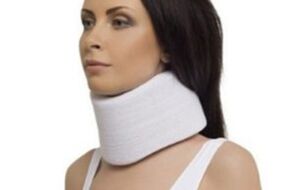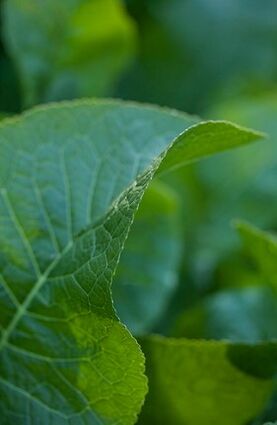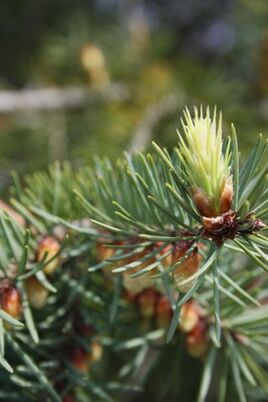
A large number of mankind suffers from cervical osteochondrosis - this is a payback for an inactive lifestyle and improper load on the back.
Cervical osteochondrosis is a degenerative-dystrophic lesion of the intervertebral disc of the cervical spine. Such lesions progressively spread to all disc elements, and over time, degenerative-dystrophic lesions reach the vertebrae, intervertebral joints and adjacent ligament apparatus.
Nearly half of the world’s adults suffer from cervical osteochondrosis. Often in everyday life, pain in the neck and joints is generally referred to as "salt deposition", but this is an incorrect definition. This is what people say and, of course, people understand this expression literally. But in fact, salt is not stored in the joints (except for diseases such as gout - thus, uric acid salts accumulate in the joints).
Treatment of osteochondrosis of the cervical spine does not achieve the purpose of "salt absorption, deposits", and others. This misconception occurs not only among patients, but also among some physicians who prescribe certain strict diets and frequent control radiographs. With osteochondrosis, there is "not a salt deposit", but reactive oxidation and, of course, no step that can cause "reabsorption of the deposit. "
The stage and stage of development of the disease
Osteochondrosis of the cervical spine is a chronic disease with a period of deterioration and remission. Those periods have different time periods. Prompt treatment of the disease is possible if the disease is the first stage of the disease and it is observed at an early stage.
The stage of development of the disease
| Power | Patient well -being, symptoms | Manifestation |
|---|---|---|
| Degree | Mild pain in the cervical spine, which may be aggravated by turning the head | Mild muscle tension in the neck |
| Grade II | Pain of greater intensity with return to shoulder or arm, increasing with rotation of the head and with flexion. In terms of well -being, there is a decrease in ability to work, weakness, headaches. |
Decreased intervertebral disc height and nerve root trap |
| III degree | Persistent pain in the cervical spine with return to the shoulder or arm. Numbness or weakness in the arm muscles. Weakness and dizziness in the patient's state of health | Restriction of movement, pain when pressing on the neck joint. Development and formation of a herniated intervertebral disc |
| Grade IV | Severe dizziness and tinnitus, coordination disorders due to compression of the vertebral arteries that feed the cerebellum and occipital lobes of the brain | The intervertebral disc is completely destroyed and has been replaced by connective tissue |
Stages of cervical osteochondrosis
| X-ray levels | Stage description |
|---|---|
| First stage | The cervical curve is smoothed, there is little change in the structure of the vertebrae |
| The second stage | Instability is expressed between vertebrae, there may be displacement of one vertebra relative to the other, slight decrease in height of the intervertebral disc |
| The third level | The height of the intervertebral disc ¼ is lower than that of the other discs, which is higher. The intervertebral joints are altered. The emergence of bone growth. The intervertebral foramen and spinal canals are narrowed. |
| Level four | The height of the intervertebral disc is reduced. The intervertebral joints are seriously altered. Bone growth becomes very large. The intervertebral foramen and spinal canals are significantly narrowed. |
Causes of osteochondrosis of the cervical spine

Cervical osteochondrosis occurs due to many factors. Let's list the main ones:
- Presence of scoliosis and incorrect posture.
- Overweight, obesity.
- Lead an inactive lifestyle, physical inactivity, inactive work, low physical activity.
- History of spinal cord injury.
- Metabolism is disturbed.
- A large amount of physical activity.
- Nervous shock, tension and stress.
- Descendants.
- Constant back tension during various activities (for drivers, programmers, etc. ).
The effect of these factors increases the load on the cervical spine, as a result of which the compensation of excessive load by the neck muscles causes their spasm and circulatory disorders in this area. As a result, this leads to degenerative changes in the cervical spine.
These factors lead to changes in the intervertebral discs of the cervical spine, as a result of which their structure changes, their nutrition is disrupted. The changes also affect the small joints between the vertebrae, the vertebral body is closed with bone growth.
The main symptoms of cervical osteochondrosis
- pain in the cervical spine. Pain may appear in the neck, and in the back of the head, and in the shoulders or arms;
- feeling weak in the hands;
- decreased sensitivity in the hands;
- restriction of neck movement, cramps when turning and tilting the head appear with bone growth on the vertebral body, with a decrease in the height of the intervertebral disc, with damage to the small joints between the cervical spine;
- dizziness, weakness, lack of coordination occurs when blood flow in the vertebral arteries decreases, which leads to a decline in blood supply to the cerebellum;
- numbness of the tongue, decreased vision and hearing occur in very severe cases of disruption of blood supply to the brain.
Treatment of cervical osteochondrosis at home
Conservative therapy
Conservative therapy of osteochondrosis of the cervical spine includes regimens, use of medications, restrictions, orthopedic methods, physiotherapeutics and spas.
Treatment should consist of the following components:
- ensure rest and unloading of the spine;
- combat pain syndrome;
- combating muscle contractions and other reflex manifestations;
- combats reactive changes in nerve elements and other soft tissues around the spine.

Some of these treatments can be done at home.
- It is very easy to follow the regimen at home to ensure complete rest and relief of the cervical spine. The patient should lie on a firm bed, there should be a small soft pillow under the head, and a small bag of warm sand or a roller with a depression should lie under the neck.
- The charm used by doctors for conservative treatment can not be done at home, but there is an alternative - a horizontal bar, on which you should hang, if possible, several times a day.
- Anesthetic blockers cannot be done at home, but the pain can be quickly overcome with other painkillers - non -steroidal anti -inflammatory drugs. Among them are effective fast-acting ointments, as well as good anti-inflammatory drugs for oral administration. Therefore, at home, can quickly relieve pain in the treatment of cervical osteochondrosis.
Attention! All medications should be taken only in consultation with your doctor!
- For home treatment, B group vitamins should be taken. Vitamins should not be in the form of injections or tablets.

It is found in the following foods (foods with the highest B vitamin content are shown):
- Berries and fruits - in pineapples, dates, dried apricots, raisins, cranberries;
- Vegetables and herbs - in potatoes, spinach, asparagus, scallions, parsley, green beans, garlic, carrots;
- In all meat products, vitamin B is contained in fairly large doses, but beef and poultry by -products (kidney, liver, heart, tongue) are very useful;
- Seafood is also very high in vitamin B. Fish, these are tuna, pink salmon and mackerel. This is very abundant in sturgeon caviar and pollock roe. Squid also contains a high percentage of B vitamins;
- High vitamin B content is found in chicken egg yolks and quail eggs;
- Nuts and seeds also contain many of these vitamins - especially pine nuts and sunflower seeds, as well as pistachios, sesame seeds and peanuts.
- Massage therapy and exercise can be used at home. A massage therapist can come to your home to give a therapeutic massage, or relatives can learn the basic methods of cervical spine massage.
Traditional methods for treating cervical osteochondrosis at home

Compress radish leaves
Cervical osteochondrosis can be treated with radish leaves, because they have anti-inflammatory effects on the neck joints when treating the disease at home.
This procedure is performed in the form of the use of compresses.
- You need to take young and fresh radish leaves and put them in boiling water for a few seconds.
- After that, the leaves must be immediately rubbed on the cervical spine.
- On it you need to put cellophane and cover the compress with a warm scarf or handkerchief.
- You need to hold the compress from the leaves as much as possible, it is recommended to put it at night.
Due to the healing properties of leaf compresses, the neck will begin to move better, and unpleasant ailments will not have a strong effect on well -being. Two fresh pieces large enough to cover the neck and upper back.
Alcohol compresses
Alcohol compresses are also often used in the treatment of cervical osteochondrosis at home.
- You need to take 300 ml of medical alcohol, 10 ml of iodine, 10 crushed analgesic tablets (powder) and 10 ml of camphor alcohol.
- Mix all this thoroughly and use as a compress on the sore part of the neck.
Compress potatoes and honey
- On a grater, grate 1 large raw potato and add 2 tablespoons of honey to the mashed mass.
- The resulting drug is spread on the tissues and applied to the cervical spine for two hours.
Pine texture

Pine shoots are used as a folk remedy in the treatment of this disease.
They must be harvested in early spring. Pine shoots should be selected no larger than 2 cm and not less than 1. 5 cm.
- Collected pine shoots must be rinsed thoroughly.
- Grind the kidneys in a meat grinder and add sugar to it in a ratio of 2 to 1, viz. for two parts of kidney, you need to take one part of sugar.
- Mix everything and refrigerate for two weeks.
- After two weeks, the product is ready. It must be taken one tablespoon three times a day for three weeks.
- You can keep pine buds in the refrigerator for 1 year.
Herbal tea

With osteochondrosis of the cervical spine, it is recommended to drink a variety of herbal teas for strengthening the body in general:
- with chamomile;
- with lingonberry and birch leaves;
- with linden color;
- with calendula and St. John's wort;
- with rose hips;
- with motherwort and ponytail.
Therefore, with the use of folk remedies and folk remedies prescribed by a doctor simultaneously, it is possible to accelerate the relief of symptoms of cervical osteochondrosis, reduce the period of exacerbation and make the remission time longer.






















